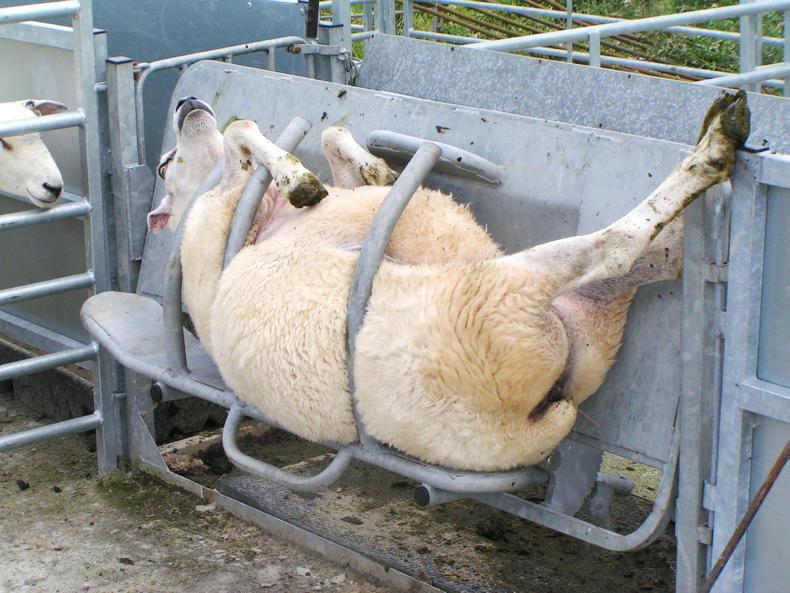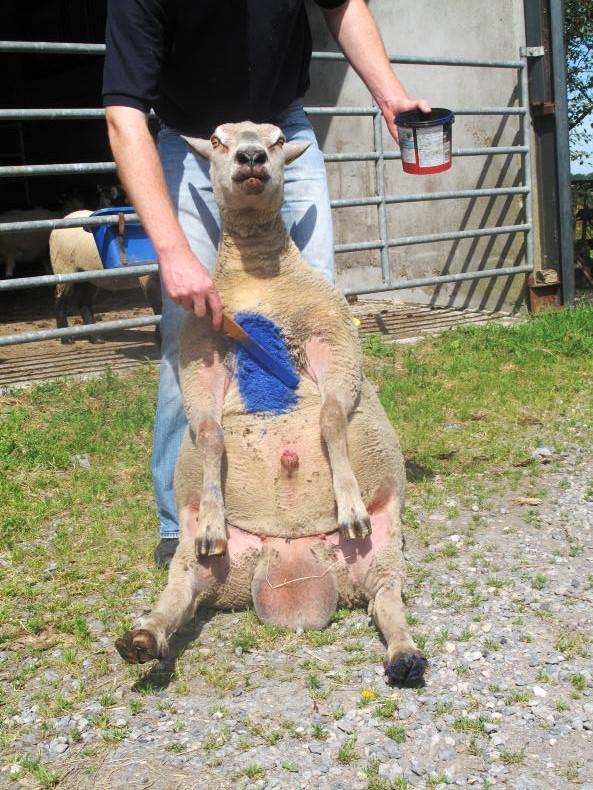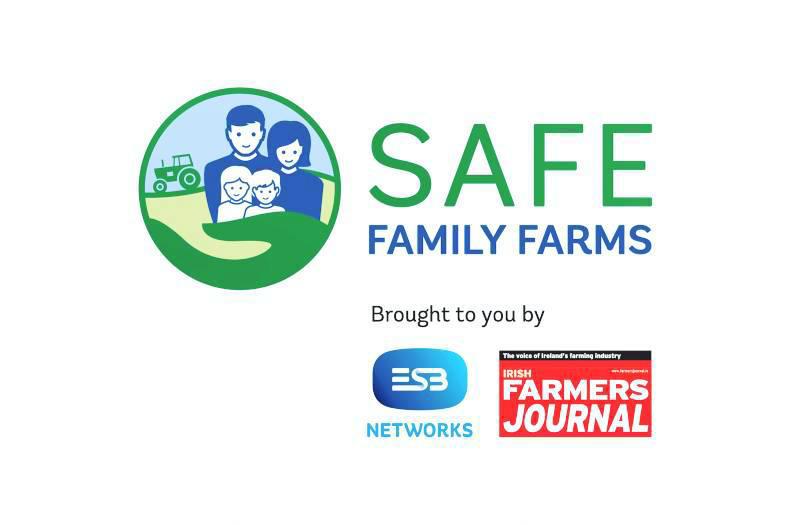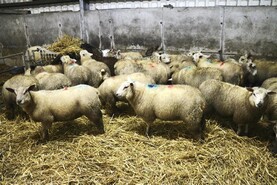Dipping and pour-on products
All sheep dips contain hazardous substances. In order to kill the parasites on sheep, the sheep dip must be absorbed. This also poses a risk for operators of harmful chemicals coming in contact with their skin and being absorbed or inhaled. Farmers and others who are users of these products must act responsibly to protect their own health and also dispose of spent sheep dip or chemical containers in a manner that poses no risk to the environment. Ensure that proper protective clothing is worn, eg face masks, gloves, boots and aprons and remember that this will need to be repeated if handling sheep soon after treatment. Always follow the guidelines and safety instructions provided with the product you are using.
General handling
 Weaning, drafting lambs for slaughter and sorting ewes for breeding and culling are just some of the tasks that involve a lot of manual handling. When handling a sheep, keep the animal close to your body and avoid having to lift the animal. If required to lift, use the proper technique by keeping your back straight, feet shoulder-width apart and lift with your legs and thigh muscles. Always get help when lifting heavy loads, or use a hoist. Using a cradle when weighing lambs will help, as will the use of a turnover crate for handling ewes or rams.
Weaning, drafting lambs for slaughter and sorting ewes for breeding and culling are just some of the tasks that involve a lot of manual handling. When handling a sheep, keep the animal close to your body and avoid having to lift the animal. If required to lift, use the proper technique by keeping your back straight, feet shoulder-width apart and lift with your legs and thigh muscles. Always get help when lifting heavy loads, or use a hoist. Using a cradle when weighing lambs will help, as will the use of a turnover crate for handling ewes or rams.
 Raddling rams can be a particularly onerous task with mature rams regularly weighing 90kg to 100kg or even more. Getting help to turn large rams is recommended. Where catching, it is also advisable to flock sheep into a smaller area where the ram has a lower chance to move and break free and as such will be easier to restrain. Some farmers find that feeding a small level of meal in the run up to mating may help to flock rams into penning with greater ease during the breeding season. Use caution when working with rams, particularly during the breeding season as they may be more excitable and easily aggravated.
Raddling rams can be a particularly onerous task with mature rams regularly weighing 90kg to 100kg or even more. Getting help to turn large rams is recommended. Where catching, it is also advisable to flock sheep into a smaller area where the ram has a lower chance to move and break free and as such will be easier to restrain. Some farmers find that feeding a small level of meal in the run up to mating may help to flock rams into penning with greater ease during the breeding season. Use caution when working with rams, particularly during the breeding season as they may be more excitable and easily aggravated.
Shearing
This is probably the most strenuous job on a sheep farm and while the majority of shearing is carried out, shearing of ewe lambs or lambs will soon begin again. It might seem unnecessary but a light stretch and warm up with gentle exercises before shearing, and cool down afterwards with slow, continuous stretches can go a long way to preventing injury.
 Ensure all of the shearing equipment is serviced and in good working order before you begin and regularly check it as you go. Maintain good posture and a straight lower back when shearing to avoid potential injury. When it comes to lower back support there are a number of options to choose from. A simple lower back belt can provide extra support where needed or you can go for a more elaborate brace support. This is effectively a harness hanging on a spring, which takes the weight of your upper body when you are bent over shearing the sheep. This takes the pressure off your lower back. Take regular breaks to alleviate fatigue.
Ensure all of the shearing equipment is serviced and in good working order before you begin and regularly check it as you go. Maintain good posture and a straight lower back when shearing to avoid potential injury. When it comes to lower back support there are a number of options to choose from. A simple lower back belt can provide extra support where needed or you can go for a more elaborate brace support. This is effectively a harness hanging on a spring, which takes the weight of your upper body when you are bent over shearing the sheep. This takes the pressure off your lower back. Take regular breaks to alleviate fatigue.
Yard design and equipment
There have been huge improvements in sheep handling equipment in the last few years. The important thing is trying to find something that suits you and your system and, more importantly, something you can afford. A good drafting system is essential in reducing the workload.  Adjustability is key so that you can tailor the size of the race and penning to the number of animals you are working with. Extra gates should always be on hand to keep the animals as tight as possible so that you are not running around the pen after them. Prices for mobile sheep handling units start anywhere from €2,000 to €3,000 and can go much higher depending on different specifications and add-ons such as software systems. There are simple units on the market too and there are critical pieces of equipment that can greatly reduce the workload.
Adjustability is key so that you can tailor the size of the race and penning to the number of animals you are working with. Extra gates should always be on hand to keep the animals as tight as possible so that you are not running around the pen after them. Prices for mobile sheep handling units start anywhere from €2,000 to €3,000 and can go much higher depending on different specifications and add-ons such as software systems. There are simple units on the market too and there are critical pieces of equipment that can greatly reduce the workload.
For example, automatic drafting gates can greatly reduce the manual handling of sheep. These units can divide the sheep by weight, identity or remote control. This allows for one operator to sort sheep with minimal effort. It also takes the lifting, pulling and dragging out of the process. If you don’t want to splash out on an automatic drafter, cheaper manual ones can be just as effective.
Remember many automatic drafting systems like these require a power source which isn’t always suitable for portable units. Electricity around livestock always poses a risk. So when you are using electrical tools around livestock, ensure that all cables are tied back and out of reach of livestock to avoid the risk of electrocution to you or the animals.
Designing a yard layout that allows sheep to move freely is also important, as is avoiding non-slip surfaces. Including equipment such as forcing gates or designing penning so that sheep move easily will deliver long-term benefits.
Personal hygiene
Animals can transmit diseases to humans via saliva, urine or contact with skin or wounds. Practise good personal hygiene and wash your hands before eating and after handling sheep.

Read more
Special focus: sheep breeding and sales season
Dipping and pour-on products
All sheep dips contain hazardous substances. In order to kill the parasites on sheep, the sheep dip must be absorbed. This also poses a risk for operators of harmful chemicals coming in contact with their skin and being absorbed or inhaled. Farmers and others who are users of these products must act responsibly to protect their own health and also dispose of spent sheep dip or chemical containers in a manner that poses no risk to the environment. Ensure that proper protective clothing is worn, eg face masks, gloves, boots and aprons and remember that this will need to be repeated if handling sheep soon after treatment. Always follow the guidelines and safety instructions provided with the product you are using.
General handling
 Weaning, drafting lambs for slaughter and sorting ewes for breeding and culling are just some of the tasks that involve a lot of manual handling. When handling a sheep, keep the animal close to your body and avoid having to lift the animal. If required to lift, use the proper technique by keeping your back straight, feet shoulder-width apart and lift with your legs and thigh muscles. Always get help when lifting heavy loads, or use a hoist. Using a cradle when weighing lambs will help, as will the use of a turnover crate for handling ewes or rams.
Weaning, drafting lambs for slaughter and sorting ewes for breeding and culling are just some of the tasks that involve a lot of manual handling. When handling a sheep, keep the animal close to your body and avoid having to lift the animal. If required to lift, use the proper technique by keeping your back straight, feet shoulder-width apart and lift with your legs and thigh muscles. Always get help when lifting heavy loads, or use a hoist. Using a cradle when weighing lambs will help, as will the use of a turnover crate for handling ewes or rams.
 Raddling rams can be a particularly onerous task with mature rams regularly weighing 90kg to 100kg or even more. Getting help to turn large rams is recommended. Where catching, it is also advisable to flock sheep into a smaller area where the ram has a lower chance to move and break free and as such will be easier to restrain. Some farmers find that feeding a small level of meal in the run up to mating may help to flock rams into penning with greater ease during the breeding season. Use caution when working with rams, particularly during the breeding season as they may be more excitable and easily aggravated.
Raddling rams can be a particularly onerous task with mature rams regularly weighing 90kg to 100kg or even more. Getting help to turn large rams is recommended. Where catching, it is also advisable to flock sheep into a smaller area where the ram has a lower chance to move and break free and as such will be easier to restrain. Some farmers find that feeding a small level of meal in the run up to mating may help to flock rams into penning with greater ease during the breeding season. Use caution when working with rams, particularly during the breeding season as they may be more excitable and easily aggravated.
Shearing
This is probably the most strenuous job on a sheep farm and while the majority of shearing is carried out, shearing of ewe lambs or lambs will soon begin again. It might seem unnecessary but a light stretch and warm up with gentle exercises before shearing, and cool down afterwards with slow, continuous stretches can go a long way to preventing injury.
 Ensure all of the shearing equipment is serviced and in good working order before you begin and regularly check it as you go. Maintain good posture and a straight lower back when shearing to avoid potential injury. When it comes to lower back support there are a number of options to choose from. A simple lower back belt can provide extra support where needed or you can go for a more elaborate brace support. This is effectively a harness hanging on a spring, which takes the weight of your upper body when you are bent over shearing the sheep. This takes the pressure off your lower back. Take regular breaks to alleviate fatigue.
Ensure all of the shearing equipment is serviced and in good working order before you begin and regularly check it as you go. Maintain good posture and a straight lower back when shearing to avoid potential injury. When it comes to lower back support there are a number of options to choose from. A simple lower back belt can provide extra support where needed or you can go for a more elaborate brace support. This is effectively a harness hanging on a spring, which takes the weight of your upper body when you are bent over shearing the sheep. This takes the pressure off your lower back. Take regular breaks to alleviate fatigue.
Yard design and equipment
There have been huge improvements in sheep handling equipment in the last few years. The important thing is trying to find something that suits you and your system and, more importantly, something you can afford. A good drafting system is essential in reducing the workload.  Adjustability is key so that you can tailor the size of the race and penning to the number of animals you are working with. Extra gates should always be on hand to keep the animals as tight as possible so that you are not running around the pen after them. Prices for mobile sheep handling units start anywhere from €2,000 to €3,000 and can go much higher depending on different specifications and add-ons such as software systems. There are simple units on the market too and there are critical pieces of equipment that can greatly reduce the workload.
Adjustability is key so that you can tailor the size of the race and penning to the number of animals you are working with. Extra gates should always be on hand to keep the animals as tight as possible so that you are not running around the pen after them. Prices for mobile sheep handling units start anywhere from €2,000 to €3,000 and can go much higher depending on different specifications and add-ons such as software systems. There are simple units on the market too and there are critical pieces of equipment that can greatly reduce the workload.
For example, automatic drafting gates can greatly reduce the manual handling of sheep. These units can divide the sheep by weight, identity or remote control. This allows for one operator to sort sheep with minimal effort. It also takes the lifting, pulling and dragging out of the process. If you don’t want to splash out on an automatic drafter, cheaper manual ones can be just as effective.
Remember many automatic drafting systems like these require a power source which isn’t always suitable for portable units. Electricity around livestock always poses a risk. So when you are using electrical tools around livestock, ensure that all cables are tied back and out of reach of livestock to avoid the risk of electrocution to you or the animals.
Designing a yard layout that allows sheep to move freely is also important, as is avoiding non-slip surfaces. Including equipment such as forcing gates or designing penning so that sheep move easily will deliver long-term benefits.
Personal hygiene
Animals can transmit diseases to humans via saliva, urine or contact with skin or wounds. Practise good personal hygiene and wash your hands before eating and after handling sheep.

Read more
Special focus: sheep breeding and sales season
 Weaning, drafting lambs for slaughter and sorting ewes for breeding and culling are just some of the tasks that involve a lot of manual handling. When handling a sheep, keep the animal close to your body and avoid having to lift the animal. If required to lift, use the proper technique by keeping your back straight, feet shoulder-width apart and lift with your legs and thigh muscles. Always get help when lifting heavy loads, or use a hoist. Using a cradle when weighing lambs will help, as will the use of a turnover crate for handling ewes or rams.
Weaning, drafting lambs for slaughter and sorting ewes for breeding and culling are just some of the tasks that involve a lot of manual handling. When handling a sheep, keep the animal close to your body and avoid having to lift the animal. If required to lift, use the proper technique by keeping your back straight, feet shoulder-width apart and lift with your legs and thigh muscles. Always get help when lifting heavy loads, or use a hoist. Using a cradle when weighing lambs will help, as will the use of a turnover crate for handling ewes or rams. Raddling rams can be a particularly onerous task with mature rams regularly weighing 90kg to 100kg or even more. Getting help to turn large rams is recommended. Where catching, it is also advisable to flock sheep into a smaller area where the ram has a lower chance to move and break free and as such will be easier to restrain. Some farmers find that feeding a small level of meal in the run up to mating may help to flock rams into penning with greater ease during the breeding season. Use caution when working with rams, particularly during the breeding season as they may be more excitable and easily aggravated.
Raddling rams can be a particularly onerous task with mature rams regularly weighing 90kg to 100kg or even more. Getting help to turn large rams is recommended. Where catching, it is also advisable to flock sheep into a smaller area where the ram has a lower chance to move and break free and as such will be easier to restrain. Some farmers find that feeding a small level of meal in the run up to mating may help to flock rams into penning with greater ease during the breeding season. Use caution when working with rams, particularly during the breeding season as they may be more excitable and easily aggravated.  Ensure all of the shearing equipment is serviced and in good working order before you begin and regularly check it as you go. Maintain good posture and a straight lower back when shearing to avoid potential injury. When it comes to lower back support there are a number of options to choose from. A simple lower back belt can provide extra support where needed or you can go for a more elaborate brace support. This is effectively a harness hanging on a spring, which takes the weight of your upper body when you are bent over shearing the sheep. This takes the pressure off your lower back. Take regular breaks to alleviate fatigue.
Ensure all of the shearing equipment is serviced and in good working order before you begin and regularly check it as you go. Maintain good posture and a straight lower back when shearing to avoid potential injury. When it comes to lower back support there are a number of options to choose from. A simple lower back belt can provide extra support where needed or you can go for a more elaborate brace support. This is effectively a harness hanging on a spring, which takes the weight of your upper body when you are bent over shearing the sheep. This takes the pressure off your lower back. Take regular breaks to alleviate fatigue.  Adjustability is key so that you can tailor the size of the race and penning to the number of animals you are working with. Extra gates should always be on hand to keep the animals as tight as possible so that you are not running around the pen after them. Prices for mobile sheep handling units start anywhere from €2,000 to €3,000 and can go much higher depending on different specifications and add-ons such as software systems. There are simple units on the market too and there are critical pieces of equipment that can greatly reduce the workload.
Adjustability is key so that you can tailor the size of the race and penning to the number of animals you are working with. Extra gates should always be on hand to keep the animals as tight as possible so that you are not running around the pen after them. Prices for mobile sheep handling units start anywhere from €2,000 to €3,000 and can go much higher depending on different specifications and add-ons such as software systems. There are simple units on the market too and there are critical pieces of equipment that can greatly reduce the workload. 





 This is a subscriber-only article
This is a subscriber-only article
















SHARING OPTIONS: